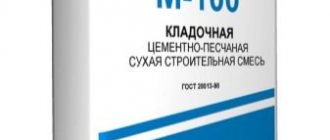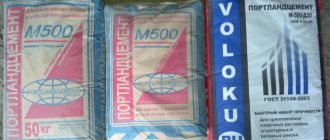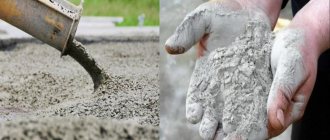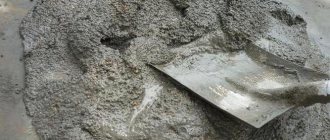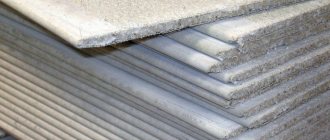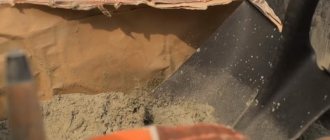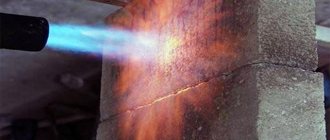When carrying out any construction and repair work, cement is almost never used in its pure form. The composition of any cement mortar, in addition to cement and water, must include other building materials, primarily sand.
We learn about cement-sand mixtures and their use from the article.
The preparation and use of cement-sand mixtures is regulated by GOST 28013-98 “Building mortars. General technical conditions".
Based on their main purpose, solutions are divided into the following types:
- masonry (including for installation work);
- facing;
- plastering
The compressive strength of mortars at design age is characterized by the following grades: M4, M10, M25, M50, M75, M100, M150, M200.
Portland cement and Portland slag cement are used as binding materials in accordance with GOST 10178;
Sand is used as a filler for construction work in accordance with GOST 8736.
What is a cement-sand mixture?
A cement-sand mixture is a building material consisting of cement and graded sand, usually including additives such as plasticizers or reinforcing fibers. The use of ready-made, factory-made CPS in dry form in bags reduces labor costs for preparing construction mixtures and ensures the correct ratio of ingredients. Due to their ease of use, ready-mixes have become popular among builders.
Interesting!
Fractionated sand is natural or artificially produced sand, sifted through a system of sieves to separate fractions by size: medium, fine, very fine, dusty. The size of the particles matters. For the preparation of cement-sand mixtures, medium-sized sand is preferable.
Dry mixes are sold ready-made, but sometimes they are made independently by mixing sand and cement in a given proportion.
Interesting!
Manufacturers produce dry DSP in bags.
Unlike factory materials standardized according to GOST, when mixing yourself, it is almost impossible to prepare the same mixture twice; Each batch will be slightly different.
Interesting!
For large-scale construction, CPPS is ordered in bulk form with specified characteristics. Factory mixtures may contain coarse sand.
The composition of mixtures is regulated by GOST 28013 “Construction Mixtures” and the international DIN standard.
Tips and tricks
When planning to prepare a cement-sand mixture, you must immediately decide in what proportion the different components will be taken, what grade of strength is needed, and what the main properties are.
It all depends on the scope of application of the mortar - so, if M50 or M75 is suitable for brickwork, then for screed prepare at least a mixture of M150, 200 and higher. The composition of any CPS includes cement, sand, water, but the result is different depending on the ratio.
Some tips from the experts:
- To prepare a plastic mixture, you can add liquid soap to the solution, previously thoroughly mixed with water.
- You need to know how to properly dilute cement and other components: first, all the dry substances are mixed, then water is added in small portions so that you can control the thickness of the mixture and achieve the ideal consistency.
- When preparing, take into account the brand of building material from which the walls are built. It is desirable that the parameters coincide - then the wall will have a homogeneous structure, reliable and durable.
- Before you make your own cement for plaster, you should take care of purchasing perlite. If you replace some of the sand with it, you will be able to achieve higher thermal insulation characteristics.
- For work, we use exclusively fresh cement, without lumps, produced according to technology and stored in optimal conditions - in this case, it will be possible to achieve the most uniform mixing and high adhesion.
- Detergent or soap is also added to the cement (the proportions remain the same, it is simply mixed with mixing water) to increase adhesion.
- The solution is best prepared in a container made of metal, plastic or wood.
- To thoroughly clean the sand from impurities that can reduce its strength, you can soak it in water for a short time.
- The consistency of the finished cement-sand mixture is usually checked with a trowel: the solution should be distributed evenly over the tool, but not run off (it is worth remembering that this rule works in the preparation of standard mixtures; for some tasks other properties may be important).
- The finished DSP is used for an hour after mixing, until the solution begins to thicken and harden. Therefore, you need to immediately prepare the required volume - exactly as much as you can produce in an hour.
- It is forbidden to dilute an already hardened solution with water, as it immediately loses its properties and can cause destruction of the structure/building.
- When mixing a mixture in a volume greater than 2 cubic meters, no drills or attachments will help - only a concrete mixer or ordering the required volume at the factory.
- The solution, which is planned to be used where minimal loads and low mass are noted, can be prepared with a reduced volume of sand. But this approach is only possible on the condition that before properly mixing the DSP, the master has precisely determined the specifics of the application and the remaining solution will not be used for the implementation of any other tasks.
- Mixing the cement-sand mass should last at least 20 minutes - this way the solution will be homogeneous and of high quality.
- The ratio of the proportions of the components is looked at in GOSTs and SNiPs (the opinion of experienced craftsmen is allowed), as well as in the recommendations of the manufacturer of cement, dry mix, etc.
Cement-sand mixture is a universal material that can be used to perform a whole range of works, obtaining the most durable and strong structures. Provided you select high-quality materials and follow the technology for preparing the mixture for the task at hand, everything can be accomplished quickly and easily.
Types of cement-sand mixtures
Dry CSPs are classified according to the following criteria:
- by percentage of cement;
- by the number of binding components;
- by the density of the frozen solution;
- by strength;
- by appointment;
- by cost.
Let's look at each classification.
Fat and skinny
Based on the percentage of cement, mixtures are divided into three types:
- fatty,
- normal,
- skinny.
The higher the cement content in the mixture, the faster the solution hardens.
Fat mixtures
The sand to cement ratio is lower than 3:1. The disadvantage of a fatty mixture is that the finished concrete is prone to cracking. To prevent it, high-grade cement is used to produce fatty mixtures.
Normal mixtures
For 3-5 parts sand, 1 part cement.
Skinny Blends
The ratio of sand and cement is higher than 5:1. Mixtures with a lean composition harden slowly and tend to crumble over time. High grade cement helps avoid this.
Binding components
As part of a cement-sand mixture, cement acts as a binder, that is, the component that reacts with water with the subsequent formation of a solid material (concrete stone).
In addition to cement, the mixture may contain other binding components:
- gypsum,
- lime,
- magnesium compounds.
Interesting!
Cement is a water-hardening binder, and gypsum, lime and magnesium compounds are air-hardening.
Mixture options containing only cement as a binder are called simple; mixtures with the addition of air-hardening binders are called complex.
Cement-based plaster mixtures have the following advantages:
- suitable for external and internal finishing and restoration work;
- provide a durable and long-lasting coating;
- good adhesion to smooth surfaces (foam blocks, aerated concrete, smooth stone, previously plastered surfaces);
- low consumption on porous surfaces;
- the cost is 1.5-2 times lower than that of gypsum;
- moisture resistance, which allows it to be used for exterior work in the house and for finishing kitchens and bathrooms.
Disadvantages of cement plasters:
- complex application in several layers or stages;
- long drying of the coating;
- porous surface;
- low decorative properties of the coating.
Advantages of mixtures with the addition of gypsum:
- plastic;
- no shrinkage;
- quick drying;
- light weight;
- vapor permeability;
- environmental friendliness;
- good sound and heat insulation properties of the coating;
- white color and susceptibility to decorative finishing, including volumetric ones.
Disadvantages of plaster with the addition of gypsum:
- low moisture resistance and unsuitability for outdoor use;
- high price;
- lower strength than cement plaster.
Light and heavy
Based on the density of the frozen solution, they are distinguished:
- heavy mixtures (over 1500 kg/m3);
- light mixtures (up to 1500 kg/m3).
Marking of mixtures by strength, technological characteristics of DSP and the use of different types of mixtures
Table 1. Cement grades and mixing proportions to obtain the mixture of the desired grade
Depending on the compressive strength, mixtures are marked with the letter “M” with a numerical designation:
- M10-M25 – mixtures with clay.
- M50-M100 - mixtures with the addition of lime, due to which the cement content is reduced. Used for plastering and repair work, leveling and eliminating minor defects such as cracks, potholes, and crevices.
- M150 - universal mixtures. They are used for masonry and plastering work, preparing mortars for screeds and repair work. The recommended layer thickness is 5-50 mm, consumption is about 16.5 kg/m2 with a layer thickness of 10 mm. Setting time is 2 hours, hardening time is 24 hours.
- M200 – assembly and masonry mixtures. They are produced in various modifications for different types of work (preparing plaster or masonry mortar for bricks, pouring screeds). Consumption for a thickness of 1 cm is about 15-17 kg/m2.
- M300 and mixtures for especially strong concrete. They are called sand concrete. More expensive than M150 mixtures, sand concrete has a narrower scope of application. They are used in cases where special strength of products is required (masonry mortars for the installation of block structures, slabs, massive screeds). Not suitable for plastering work.
Table 2. Brands and properties of mixtures
Important!
In accordance with GOST requirements, the number next to the letter “M” shows what compressive load the hardened mortar prepared from this mixture can withstand.
Mixtures for various purposes
Table 3. Composition and purpose of mixtures
Depending on the purpose, mixtures are divided into the following types:
- Mixtures for screeds. They are made on the basis of cement TsEM I 32.5N GOST 31108-2016 (grade M400), and sand in a ratio of 1:2 or TsEM I 42.5N GOST 31108-2016 (grade M500), with sand 1:3. To reduce the risk of cracks in the screed, synthetic fiber fiber is added (0.7-0.9 kg per cubic meter of mixture).
- Mixtures for bricklaying. The ratio of cement and sand is from 1:3 to 1:5.
- Mixes for plaster. They are made on the basis of M200 or M300 cement. The proportion is 1 part cement to 3 parts sand.
Important!
Cement-sand mixtures, like cement, lose their properties during long-term storage. After a year, the strength is reduced by half. In open packaging, the loss of material properties occurs faster.
Dear and... not very
Cement-sand mixtures are classified into three groups based on price:
- "Pants". More expensive than building materials purchased separately, 2-2.5 times. The mixtures contain special cement.
- Cement-based mixtures with rheological additives that increase the adhesion and water-retaining characteristics of the mixture. Used when mixing solutions for plastering and laying tiles.
- Mixtures with surface additives that are resistant to abrasion. The most expensive.
Cement-sand mixtures may contain additives that give them special properties:
- Plasticizers. They impart plasticity and mobility to the solution, which reduces the consumption of cement and water, improves the workability of the mixture, eliminates air bubbles, increasing the density of the concrete stone, reduces shrinkage and reduces the risk of cracks. Used for pouring foundations, screeds, and heated floors.
- Hardening speed regulators. Allows you to speed up or slow down the hardening of the material.
- Additives that impart hydrophobicity to concrete and mortar.
- Additives for frost resistance. They are of great importance for carrying out concrete work at temperatures below 0 degrees. Celsius.
- Additives that provide the ability of concrete to retain water, reducing the amount of unbound water. They are used when working on moisture-absorbing substrates (sand-lime brick, foam concrete).
Types and areas of their use
Universal dry mixtures differ in composition and purpose, they have their own characteristics and characteristics.
You should pay attention to the marking, the number in which indicates the strength of the original product
M100
M100 products are intended for manual plastering and putty. The mixture is applied in an even thin layer, which leads to material savings. She is easy and pleasant to work with. The mixture retains its properties for two hours from the moment of dilution. Prices for M100 products are quite affordable.
M150
M150 products are the most popular of the varieties of universal mixtures. It is used in virtually all construction work using dry compounds. Unlike M300 and M400, it is used for masonry, plaster, and screed. Factory packaging is presented in 50 kg bags, less often they produce products in 25 kg packaging.
The universal mixture includes Portland cement, sand, mineral powder, plasticizers and other additives. The finished composition can only be diluted with cold water in the proportion indicated on the package.
M150 products are endowed with many advantages: they are reliable, frost-resistant, have good adhesion to various surfaces, high moisture resistance and vapor permeability. It is used in any climatic conditions.
The disadvantages of M150 include poor resistance to increased loads (no more than 150 kg per 1 cubic cm), therefore such a mixture is not used for work with the foundations of multi-story buildings.
The name “universal” speaks of the variety of applications of the M150 composition.
- The plaster mixture is designed for interior and exterior plastering work. Layer thickness can be applied up to 50 mm. After mixing, work should begin immediately: the mixture is in a pliable state for 2 hours. The plaster becomes completely dry and strong after 4 weeks.
- Using the M150 screed mixture, the floors in the rooms are leveled. Checking the level and setting the beacons, the floor is poured with a thickness of 1 to 10 cm. Thanks to the cement base, the floor acquires durable qualities that are resistant to temperature changes.
- The masonry mixture is used for laying gas silicate blocks and bricks of all types. M150 products can be used indoors and outdoors in cold or hot weather; weather conditions do not affect the quality of masonry. The dry mixture has proven itself well in rooms with high humidity.
M200
Product M200 is a masonry mixture. It consists of Portland cement, river sand and special additives. Designed for laying bricks, concreting flooring, constructing simple foundations, repairing walls and processing seams in concrete structures.
M200 can be used for laying garden tiles, as well as for plastering and puttying walls. It is available in bags weighing 50 kg.
M300
Sand concrete M300 appeared on the construction market not long ago, but has already gained popularity. Unlike the M150, it is designed for heavy loads. The products are durable and reliable, have a long service life, adapt well to weather conditions, are moisture resistant, environmentally friendly, and do not shrink. M300 consists of Portland cement, which contains gypsum, sand and crushed clinker. Products are packaged in 50 kg bags, less often in 200 kg bags for industrial scale.
Due to its special strength, the composition is used in all areas of construction work in all climatic conditions. During installation, they are used to install the foundation, floor screed, leveling walls and other surfaces. The product has proven itself well as a grout for cracks during work at emergency sites. The composition is used when laying garden paths, stairs, and borders. The mixture is used in the production of expanded clay concrete.
According to their properties, depending on the application, M300 products are divided into several subtypes.
- Coarse grain has incredible strength and long service life. With its help you can fill the foundations of high-rise buildings.
- Medium-grain is used for screeds, self-leveling floors, work with borders and garden paths. It is used wherever a medium-grained fraction of the mixture is required.
- Fine-grained is also reliable and durable; it is used for plastering work.
When choosing a universal dry composition, you should remember: the more famous the brand and the higher the grade of the product, the more expensive the product and the more reliable its technical properties.
For information on what dry building mixtures are, see the following video.
Consumption of cement-sand mixtures
Table 4. Composition of mixtures and consumption of components
Mixtures are consumed depending on the type of work and the thickness of the applied layer. To accurately calculate the materials used, you can make a test sample and build on its indicators.
For filling the screed
To calculate the amount of material for the screed, you need to find the cubic capacity of the solution used for the fill. To do this, it is necessary to multiply the floor area of the room by the thickness of the layer, the value of which for a screed rarely exceeds 30 cm. For example, in the case of pouring a screed 10 cm thick in a room with a floor area of 100 m2, you will need 10 cubic meters of solution, the preparation of which requires from 555 to 713 kg of dry mixture (depending on its brand).
Important!
The higher the grade of the mixture, the higher its density. To prepare a cube of solution from the M100 mixture, you will need 550-600 kg or 700 kg of the mixture TsEM I 32.5N GOST 31108-2016 (grade M400).
Semi-dry mixture for screeds
Semi-dry mixtures can be used to make screeds. Hard (semi-dry) mixtures have a low water content. These mixtures, in addition to cement, sand and water, include fiber fibre, plasticizer and, if necessary, anti-freeze additives. The semi-dry mixture is supplied through hoses using a special device with a pump. Beacons are made from the semi-dry mixture and poured.
Advantages of the semi-dry mixture:
- performing the screed in one step;
- fast hardening;
- reduction of shrinkage and cracking.
Semi-dry screed is a high-tech process that improves the quality of work.
Wet screed
It is made from cement-sand mixtures of grades M150-300. The dry mixture is mixed with water on the spot. The surfaces to be poured are pre-primed. The primer forms a thin film with increased adhesive properties. The primer film retains moisture in the screed.
Thermal conductivity coefficient of cement-sand screed
The thermal conductivity of the floor screed depends on the percentage of cement and sand. An ordinary cement-sand mortar has a thermal conductivity coefficient of 1.2 W/m*K, which means high thermal conductivity of the material and significant heat loss, that is, the floor will be cold, and more money will be spent on heating.
Important!
The thermal conductivity coefficient of the screed during engineering calculations is selected from reference tables, which show indicators depending on the material used. The thermal conductivity coefficient of building and thermal insulation materials is 0.02-2.1 W/m*K and depends on temperature (increases with increasing temperature). As the density of the material increases, it grows, but the presence of cavities, pores and air layers does not allow the material to be considered homogeneous. Since the thermal conductivity of gases is in the range of 0.004 to 0.4 W/m*K, the overall density decreases; in this case, heat transfer decreases and the thermal conductivity of the screed decreases.
Expanded clay or expanded perlite can be used as a thermal insulating filler that reduces the thermal conductivity of the floor screed; however, the more filler, the less durable the screed will be. In addition, large filler makes it difficult to create a flat floor surface.
For plastering walls
Material consumption can only be determined approximately, because walls can be uneven, with protrusions, depressions, and gaps.
Therefore, the average layer depth is determined for calculations.
Important!
The thickness of the plaster layer is 5-30 mm. Lime is often added to the plaster mortar, which reduces the consumption of CPS.
With a layer thickness of 10 mm, the consumption of the M400 mixture per 1 m2 is 1.6 kg, M500 - 1.4 kg.
For bricklaying
For masonry work, a mixture of M100 or M200 is used. Laying 1 m3 of wall requires 250 g of dry fiber cement.
Important!
It is necessary to clarify the data according to the regulatory documentation.
How to save CPS
To reduce the consumption of CPS, fillers are used:
- expanded clay to reduce thermal conductivity when pouring screeds;
- lime mortar for plaster.
In addition, you can use high-quality cement, reducing its amount in the mixture, or backfill foundations to reduce solution consumption.
How much mixture is used?
Depending on the specifics of the work performed, a solution based on Portland cement and river sand is consumed in the following volume:
The cement-sand mixture can be used not only as a mortar for laying tiles, bricks and blocks, but also as a mortar for plastering
- when performing plastering work and pouring screed, the consumption is up to 16 kg per square meter, depending on the brand of mortar;
- installation and masonry compositions intended for finishing activities, facing works and wall masonry are consumed in the amount of 7–8 kg/m2;
- Foundation DSPs, which have increased strength characteristics, are consumed in an increased volume, reaching 20 kg/m2.
Knowing the amount of building materials consumed, it is easy to calculate the amount of upcoming costs.
Advantages and disadvantages of cement-sand mixtures
The popularity of DSPs is due to the advantages that their use provides:
- Reducing the number of necessary operations when mixing the solution.
- Convenience in the preparation of solutions (no need to calculate components).
- The presence of additional additives that provide the required properties of concrete, added in the required percentage.
- Standardized composition with predictable characteristics.
The disadvantage of CPS is its higher price compared to sand and cement purchased separately.
How to properly dilute
Before preparing the mixture, you need to find out how to dilute the cement correctly. Changing the order of work and violating the technology entails a decrease in the technical characteristics of the material, which is unacceptable.
How to dilute cement and other components correctly:
- Filling the container with one layer of cement, then a layer of sand and alternating until the number of layers reaches at least six. Cement and sand should be poured in the form of a bed with a total height of up to 30 centimeters.
- Mix the dry ingredients in a container with a shovel until a homogeneous mass is obtained. Sift the composition through a sieve with 3x3 millimeter mesh. This is necessary to ensure uniformity of the composition.
- After all the components are mixed (sand and cement), the solution can be mixed. Water is added carefully and gradually, slowly, fully controlling the density level of the CSP.
When preparing a solution, the ratio of sand and cement, the quality of materials and water play a key role. So, it is important to use the liquid at the right temperature - the water should not be very hot and not very cold, as close as possible to the natural environment. The air temperature should be above +5 degrees.
Errors when using mixtures
Standard factory-produced mixtures balanced in composition provide the required result. But sometimes the desired result does not occur; This could be due to the following errors:
- Stale mixture. With each month of storage, the properties of cement weaken, and the grade of the mixture decreases.
- Wrong choice of brand of mixture, for example, a weak mixture for pouring the foundation.
- Neglect of special conditions, for example, using a mixture without anti-freeze additives at low temperatures.
- Violation of the conditions of finishing work (each subsequent layer must be equal or decrease in strength in comparison with the previous one).
- Improper preparation of the base.
- When preparing CPS yourself, failure to comply with the proportions, use of sand that is too fine or dusty, material contaminated with clay or cement that has lain for a long time.
Peculiarities
Dry mix M-300 is a ready-made masonry mixture, the components of which are selected in the required proportions. Before use, the composition is diluted with water in the volume specified by the manufacturer and mixed mechanically until smooth.
The mixture is sand concrete, since it is based on purified fine-grained concrete and Portland cement. The dimensions of the first do not exceed 3 mm; the Portland cement used has a grade strength of M-400 or M-500). To ensure certain characteristics (frost resistance, moisture strength, and so on), plasticizers are introduced.
Various reinforcing fibers may be present in compositions operated at subzero temperatures. To improve adhesion, a special type of clay, coarse sand, or granite chips are sometimes added.
Unlike conventional concrete mortars, M-300 sand concrete is distinguished by its ease of preparation, plasticity (suitable for laying in a thin layer, which is necessary for certain types of masonry), high strength, and economical consumption. The M300 mixture is a masonry mixture, that is, it is used for fixing bricks or masonry stones. In addition, it can be used as a concrete mixture for casting.
The composition is characterized by non-shrinkage, which allows it to be used as a floor screed. And thanks to its increased strength and wear resistance, the mixture is used even when organizing high-strength floors. The thixotropy of the composition allows it to be used also for leveling floors, as well as sealing cracks in concrete surfaces.
The material is suitable for both private housing construction and the construction of industrial and administrative facilities, as well as the installation of basements and garages. It is used when pouring the foundation, including in places where concrete and reinforcing sections meet. The mixture is also used to create paths in private suburban areas. In its properties, the material resembles fine-grained concrete, therefore it is used both outside and indoors.
DSP for screed, plastering and masonry
To make smooth and reliable floors, the materials include various components that allow you to make a high-quality screed both with and without heating. The Ceresit company produces bulk materials that are used indoors and outdoors. The mixture produced under its brand has the properties to withstand moderate mechanical loads.
Ceresit
The series of floor screeds includes representatives of these materials that can be used in various conditions. Before purchasing, you can read the instructions on the bag and determine which brand of screed you should buy. The floor is poured using standard technology.
For plastering facades, universal cement plasters “KNAUF” are purchased. These materials withstand the vagaries of the weather and do not require complex equipment to carry out the work.
KNAUF
The application of plaster is carried out using the standard manual method. It is also possible to finish the facade using a mechanized application method. It is recommended to use metal corners to protect corners. This surface leveling agent can be used for the construction of brickwork.
For masonry work, you can use ready-made compounds. This material is cost-effective to use in small volumes.
Ready-made formulations
For example, for erecting small decorative columns or installing a stove apron in a bathhouse. The main component is a sand-cement composition, which gives the product the same qualities as factory materials. The product is resistant to frost and high temperatures. It can be used to fill not particularly critical concrete structures.
Peculiarities
Cement mortars with sand are used to perform a wide variety of work during the construction, finishing, and renovation of buildings. It’s not difficult to make a mixture with your own hands, but you need to know the exact proportions of cement, sand and water. The easiest way to mix is to use a concrete mixer, renting or purchasing one.
Before making a solution of cement and sand, it is necessary to decide on the scope of application, since the proportions differ within significant limits. The most popular is considered to be DSP for brickwork: cement-sand mortar is used to create load-bearing walls, and with the addition of lime for internal walls.
The composition of the cement mortar largely depends on the working conditions and operation. If work is carried out in frosty conditions, then special anti-freeze additives are added to the composition to prevent the CPS from freezing. But they are suitable for working in frosts below -20 degrees (it’s better not to do anything at all, but to wait for warmer weather), since they will not be flexible and flexible enough.
If a cement solution is prepared for use in monolithic hearths with an open fire source, in the construction of a furnace or firebox, then heat-resistant fire-resistant mixtures are created: from cement of at least M400 grade, with crushed brick, fine fireclay sand.
For each type of task and working conditions, a solution is prepared from basic materials, but in different proportions and with the addition of additives and plasticizers. As a rule, additives change one parameter - this could be the rate of hardening, mobility, frost resistance, etc. Each master determines priority tasks and performs calculations before preparing the cement mortar.
What do supplements provide for CSP?
So, the composition of modern cement-sand mixtures necessarily includes additives to improve their properties and to facilitate work in which a mortar prepared from them is used: plaster, masonry, floor screed and any other.
Plasticizing, antifreeze and other specialized additives
The process of hardening and strength gain for all mortars made on the basis of cement-sand mixtures, including concrete, is determined by the maturation and hardening of the binder component, that is, cement. This occurs as a result of an exothermic chemical reaction between cement and water. That is, water is added not only for plasticity and mobility, but also for the formation of solid cement stone. There are two problems associated with the use of water:
Problem one.
The optimal water-cement ratio is 0.4. That is, for every kilogram of cement you need 400 g of water. However, this is not enough for the mixture to be sufficiently mobile. If you increase the proportion of water, the quality of the hardened mixture will subsequently be worse. And this is where an additive such as a plasticizer comes to the rescue: it increases the fluidity of the cement mortar several times without adding excess water and maintains it in working condition for a long time.
Problem two.
At normal temperatures, the initial stage of hardening of the solution - setting - requires only 2-3 hours. As the temperature decreases, the hardening process gradually slows down. At zero value, setting occurs after 15-20 hours, and with further cooling, when the heat released as a result of the reaction is not enough and the water eventually freezes, the process of strength gain stops. The best solution to the problem is an antifreeze additive. Its operating principle is a significant reduction in the freezing point of water. It also works as a strength gain accelerator.
In addition to solving underlying problems, supplements can help improve health benefits such as:
- Increasing the water repellency of CFRP and concrete—a waterproofing additive.
- Strengthening mechanical strength is a highly effective fiber additive - fiber, which contains thin steel, glass, basalt or polypropylene fiber. When kneading, the fiber is easily distributed throughout the mixture. In the production of polymer fibers, special impregnation is used to stimulate this property.
Complex Supplements
Recently, thanks to the successful development of chemical science and production, fundamentally new additives for cement mixtures have appeared. They are distinguished by increased efficiency, expanded functionality, and universal application. And also ease of use - it is much easier when, instead of a set of products with different properties, one multifunctional complex additive is used. For a clear example of versatility, we present a table with data on some GOODHIM products.
Table 2.
Additives for concrete and CFRP produced by GOODHIM enterprises.
| The product's name | Properties |
| Superplasticizer INTERPLAST AT | Increasing the mobility of mixtures, saving cement - 15%, frost resistance and water resistance during operation. |
| FROST PREMIUM, anti-frost additive with plasticizer | Strength gain at low temperatures, down to -25 degrees, possibly up to 30% at one day of age; 3-4 times increase in fluidity with a decrease in water content by 15%. |
| FROST XKM -25.5, antifreeze additive | Hardening at negative temperatures, up to -25 degrees; accelerated strength gain, reduction of setting time by 3 times; long-term preservation of mixture mobility; cement savings - 10%; water saving - 5-10%; increase in operational strength by 10-15%; increasing the grade of cement. |
| INTERPLAST AT S GIDRO, hydrophobic additive | Hydrophobization and reduction of capillary suction, increased workability, antiseptic properties, minimization of efflorescence. |
| FIBRA fiberglass | Increased strength, wear resistance, frost resistance, elasticity, water resistance, resistance to aggressive environments; prevention of cracking and delamination. |
| Plasticizer INTERPLAST R, summer additive | Maintains workability for 24 hours, increases air entrainment, enhances adhesion. |
| Plasticizer FROST TF R, winter additive | 30% strength gain at negative temperatures, up to -15 degrees; increased air entrainment by 10-12%; increased mobility and long life of the solution; high adhesion; prevention of delamination and efflorescence. |
Quick answers
Special additives - plasticizers - strengthen the cement mortar. By increasing elasticity, they prevent the formation of cracks. Also, reinforcing fibrous additives such as fiber are used to strengthen solutions.
0.4 - 0.5 parts of water are added per unit of mixture. First, the mixture is poured into the container, then water is poured into the recess. Kneading is done first with your hands, then with the help of a tool. Always read the instructions for the finished mixture - the mixing option there may differ from the average.
In its natural form, river sand is preferable, since it does not contain clay impurities that reduce the strength, which are present in quarry sand. Another thing is alluvial sand, that is, high-quality quarry sand - this is the best option for the best quality screed.
Gypsum can be used as a binder. But only for dry interior spaces. Gypsum mixtures look more beautiful, weigh lighter, and form smooth surfaces that do not need to be plastered. But they are less durable and absorb moisture well.
The length and width of the floor are measured. The area is located. Multiplied by the required screed height. The resulting volume is multiplied by the density of the mixture indicated in the technical description or by the calculated one. An approximate calculation is carried out through bulk density, which is approximately the same for dry sand and dry cement. Add 10-15% of the total weight for random losses.
